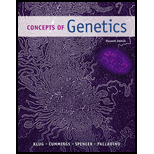
(a)
To determine:
The way for knowing how many genes control development in an organism like Drosophila
Introduction:
The Drosophila melanogaster is the widely used model organism in the field of genetics and developmental biology. It is also called as the fruit fly. It is suitable for laboratory studies since it carries only four chromosomes and hence creating a loss of function and gain of function of these genes is very easy. There is various reason for using this as a model organism which includes low cost, morphology is easy to identify, small in size, genetic crossing can be done, etc.
(b)
To determine:
The experimental evidence which demonstrates that molecular gradients in the egg control development.
Introduction:
The Drosophila melanogaster is the widely used model organism in the field of genetics and developmental biology. It is also called as the fruit fly. It is suitable for laboratory studies since it carries only four chromosomes and hence creating a loss of function and gain of function of these genes is very easy. There are various reason for using this as a model organism which includes low cost, morphology is easy to identify, small in size, genetic crossing can be done, etc.
(c)
To determine:
The reason by which an individual discovers that selector genes specify which adult structures will be formed by body segments.
Introduction:
The Drosophila melanogaster is the widely used model organism in the field of genetics and developmental biology. It is also called as the fruit fly. It is suitable for laboratory studies since it carries only four chromosomes and hence creating a loss of function and gain of function of these genes is very easy. There is various reason for using this as a model organism which includes low cost, morphology is easy to identify, small in size, genetic crossing can be done, etc.
(d)
To determine:
That how an individual learns about the levels of gene regulation involved in vulval development in C. elegans
Introduction:
Caenorhabditiselegans is the widely used model for cell-cell interaction in the developmental process. It is the nematode that usually feeds bacteria for the source of energy. The size of adult C. elegans is about 1mm long which can be grown in Petri dish with bacteria. It has a less generation time usually in three days from zygote to fertile adult. It has four larval stages namely L1, L2, L3, and L4. The hatched L1 larva usually leave through the vulval opening.
(e)
To determine:
That how an individual know that eye formation in all animals is controlled by a binary switch gene
Introduction:
The Drosophila melanogaster is the widely used model organism in the field of genetics and developmental biology. It is also called as the fruit fly. It is suitable for laboratory studies since it carries only four chromosomes and hence creating a loss of function and gain of function of these genes is very easy. There is various reason for using this as a model organism which includes low cost, morphology is easy to identify, small in size, genetic crossing can be done, etc.
Want to see the full answer?
Check out a sample textbook solution
Chapter 18 Solutions
Concepts of Genetics (11th Edition)
- Not part of a graded assignment, from a past midtermarrow_forwardNoggin mutation: The mouse, one of the phenotypic consequences of Noggin mutationis mispatterning of the spinal cord, in the posterior region of the mouse embryo, suchthat in the hindlimb region the more ventral fates are lost, and the dorsal Pax3 domain isexpanded. (this experiment is not in the lectures).a. Hypothesis for why: What would be your hypothesis for why the ventral fatesare lost and dorsal fates expanded? Include in your answer the words notochord,BMP, SHH and either (or both of) surface ectoderm or lateral plate mesodermarrow_forwardNot part of a graded assignment, from a past midtermarrow_forward
- Explain in a flowcharts organazing the words down below: genetics Chromosomes Inheritance DNA & Genes Mutations Proteinsarrow_forwardplease helparrow_forwardWhat does the heavy dark line along collecting duct tell us about water reabsorption in this individual at this time? What does the heavy dark line along collecting duct tell us about ADH secretion in this individual at this time?arrow_forward
 Human Anatomy & Physiology (11th Edition)BiologyISBN:9780134580999Author:Elaine N. Marieb, Katja N. HoehnPublisher:PEARSON
Human Anatomy & Physiology (11th Edition)BiologyISBN:9780134580999Author:Elaine N. Marieb, Katja N. HoehnPublisher:PEARSON Biology 2eBiologyISBN:9781947172517Author:Matthew Douglas, Jung Choi, Mary Ann ClarkPublisher:OpenStax
Biology 2eBiologyISBN:9781947172517Author:Matthew Douglas, Jung Choi, Mary Ann ClarkPublisher:OpenStax Anatomy & PhysiologyBiologyISBN:9781259398629Author:McKinley, Michael P., O'loughlin, Valerie Dean, Bidle, Theresa StouterPublisher:Mcgraw Hill Education,
Anatomy & PhysiologyBiologyISBN:9781259398629Author:McKinley, Michael P., O'loughlin, Valerie Dean, Bidle, Theresa StouterPublisher:Mcgraw Hill Education, Molecular Biology of the Cell (Sixth Edition)BiologyISBN:9780815344322Author:Bruce Alberts, Alexander D. Johnson, Julian Lewis, David Morgan, Martin Raff, Keith Roberts, Peter WalterPublisher:W. W. Norton & Company
Molecular Biology of the Cell (Sixth Edition)BiologyISBN:9780815344322Author:Bruce Alberts, Alexander D. Johnson, Julian Lewis, David Morgan, Martin Raff, Keith Roberts, Peter WalterPublisher:W. W. Norton & Company Laboratory Manual For Human Anatomy & PhysiologyBiologyISBN:9781260159363Author:Martin, Terry R., Prentice-craver, CynthiaPublisher:McGraw-Hill Publishing Co.
Laboratory Manual For Human Anatomy & PhysiologyBiologyISBN:9781260159363Author:Martin, Terry R., Prentice-craver, CynthiaPublisher:McGraw-Hill Publishing Co. Inquiry Into Life (16th Edition)BiologyISBN:9781260231700Author:Sylvia S. Mader, Michael WindelspechtPublisher:McGraw Hill Education
Inquiry Into Life (16th Edition)BiologyISBN:9781260231700Author:Sylvia S. Mader, Michael WindelspechtPublisher:McGraw Hill Education





